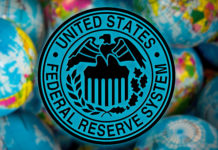This week was all about central banks with monetary policy meetings around the globe. In the US, the Fed maintained the policy rate unchanged at 5.25%-5.50% as widely anticipated, but surprised hawkishly with higher median rate projections (dot plots). The median ‘dots’ were revised up by 50bp for both 2024 (to 5.1%) and 2025 (to 3.9%) which moved treasury yields higher. The higher projected policy rate was due to a large upward revision of the growth outlook for 2023 to 2.1% (from 1.0%) and 1.5% (from 1.1%) for 2024, while inflation forecasts only received minor adjustments. For more details, see Fed review: Upbeat on growth, 20 September.
Bank of England (BoE) decided to leave the policy rate unchanged at 5.25% and step up QT as five members voted for a pause and four for a hike. The outcome of the meeting was more uncertain than usual as inflation figures released a day before the meeting showed a significantly larger decline in both in headline and core figures than expected. For more details, see BoE review: End to the hiking cycle, but not GBP headwinds, 21 September.
The Bank of Japan kept its QQE with yield control unchanged as expected. The policy rate stayed at -0.1% and the 10-year yield target around 0% with +/- 0.50% tolerance band and a firm cap at 1.0%. The central bank of Turkey increased the policy rate as expected while the Swiss National Bank surprised both analysts and markets by leaving the policy rate unchanged. For details on Sveriges Riksbank and Norges Bank, see Scandi Update section.
The September PMIs showed that the euro area and UK economy ended Q3 in contraction as waning demand lead to a further decline in activity. The service sector surprised positively in the euro area and negatively in the UK but both remain below 50. Price pressures are still large in the service sectors as wages push up input costs.
Focus next week will be on inflation in both the US and euro area on Friday. Inflation drivers continue to paint a mixed picture, as price pressures from food and energy ease while underlying inflation still remains uncomfortably high for the Fed and ECB. In the US core PCE inflation is expected to print around 0.2% m/m as in August while headline is expected to increase to 0.4% m/m from 0.2% m/m. In the euro area, we expect a decline in headline HICP to 4.4% from 5.3% in August driven by negative energy inflation, lower food prices, and a downtick in core inflation from 5.3% to 4.8%.
In China, we receive the September Caxin PMIs for both manufacturing and services on Friday. After a decent rebound in manufacturing PMIs in August from 49.2 to 51.0 we see downside risks to the September print and expect a decline to 50.5. The series is quite erratic and last month’s increase seemed a bit too strong relative to the releases on retail sales and housing.
Other relevant data releases next week are US jobless claims, durable goods orders and conference board consumer sentiment. We expect US real private consumption growth volume to land around zero or even slightly negative. In the euro area, we receive money supply (M3) figures and Ifo figures from Germany. Finally, plenty of focus will also be Fed comments after this week’s meeting.












